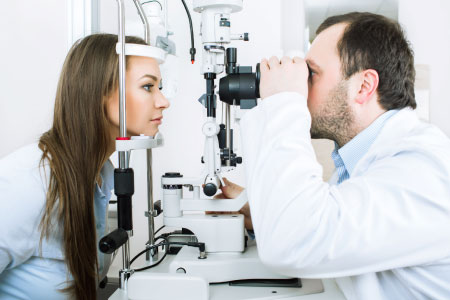Here comes a plethora of new and revised ICD-10-CM codes for ophthalmology and optometry—from more specific code choices to identify the affected eye and eyelid, to brand-new code sets for rosacea conjunctivitis and “droopy brows.” Make sure you’re ready to use the new codes come October 1, 2018.
Ophthalmology is one of the top three specialties most affected by the 2019 ICD-10 coding updates, more than 100 new and revised codes, according to ophthalmology coding expert Jeffrey Restuccio. Most relevant code changes are in Chapters 2, 6, and 7, he notes in his ProfEdOnDemand webinar, “2019 ICD-10 Coding Changes for Ophthalmology & Optometry.”
Expect More Specificity in Chapter 7
Heads up: Chapter 7 (Diseases of the Eye and Adnexa) contains a whole host of new and revised 2019 ICD-10 codes. Many of the changes involve the addition of specifications for right versus left eye and upper versus lower eyelids.
Some codes now allow you to specify the affected eye, while others have far more specific options. For instance, H01.01 — Ulcerative blepharitis has two new code options:
- 01A — …right eye, upper and lower eyelids
- 01B — …left eye, upper and lower eyelids
Another example: But the new code H02.88 — Meibomian gland dysfunction of eyelid offers a variety of options, not just right or left eye:
- 881 — Meibomian gland dysfunction right upper eyelid
- 882 — …right lower eyelid
- 883 — …of right eye, unspecified eyelid
- 884 — …left upper eyelid
- 885 — …left lower eyelid
- 886 — …of left eye, unspecified eyelid
- 889 — …of unspecified eye, unspecified eyelid
- 88A — …right eye, upper and lower eyelids
- 88B — …left eye, upper and lower eyelids
Use New Codes for Conjunctivitis, Brow Ptosis
In addition to the new eye and eyelid coding options, CMS also created new codes for many eye diseases and conditions. Under H10.8 — Other conjunctivitis, you now have H10.82 — Rosacea conjunctivitis. CMS instructs you to code underlying rosacea dermatitis (L71.-) first. Here are your additional coding options:
- 821 — Rosacea conjunctivitis, right eye
- 822 — …left eye
- 823 — …bilateral
- 829 — …unspecified eye
More: CMS added a new code set under H57.8 — Other specified disorders of eye and adnexa:
- 81 — Brow ptosis
- 811 — Brow ptosis, right
- 812 — …left
- 813 — …bilateral
- 819 — …unspecified
- 89 — Other specified disorders of eye and adnexa
Also, pay attention to the revisions for H04 — Disorders of lacrimal system, where CMS revised the diagnosis code descriptions to remove the reference to “lacrimal gland,” notes the American Society of Ophthalmic Administrators (ASOA). For H10.51 — Ligneous conjunctivitis, CMS added a statement to also code the underlying condition if known, such as plasminogen deficiency (E88.02).
Don’t overlook: Of course, your ophthalmology and optometry diagnosis coding expands well beyond Chapter 7. For instance, pay attention to new codes and code sets in Chapter 2 (Neoplasms), such as malignant melanoma of the eyelid (C43.1-), Merkel cell carcinoma (C4A.11-), unspecified malignant neoplasm (C44.102- and C44.109-), basal cell carcinoma (C44.11-), squamous cell carcinoma (C44.12-), sebaceous cell carcinoma (C44.13-), and melanoma in situ of eyelid (D03.1-).
Take These Steps to Make Your Job Easier
Remember: The updated 2019 ICD-10-CM codes are effective as of this October. So before the end of September, make sure you review and become familiar with the new codes, Health First recommends. You should also:
- Add the new codes to your “favorites” list in your Electronic Health Record (EHR) system;
- Review EHR plans, assessments, and documents that were mapped from old codes to new codes; and
- Review and update the “code rules” you created in your EHR that are impacted by the new, deleted, and revised 2019 ICD-10 codes.
Bottom line: Carriers are basing their reimbursement on “disease specificity” for keratoconus, pterygiums, amblyopia, glaucoma, cataracts, and more, Restuccio says. You need to tell the patient’s full health story to support clinical documentation improvement (CDI) and satisfy the Merit-based Incentive Payment System (MIPS). Get started now to prepare for the October 1 effective date for these new and revised ICD-10 codes.


